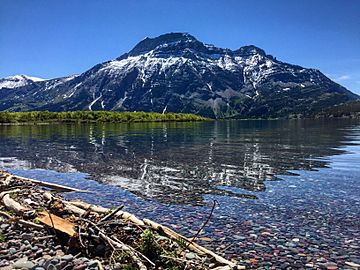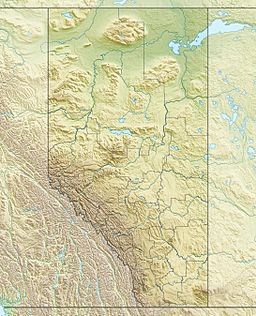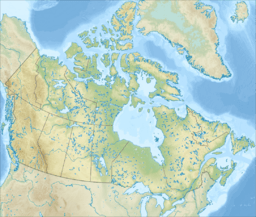Vimy Peak facts for kids
Quick facts for kids Vimy Peak |
|
|---|---|

Vimy Peak
|
|
| Highest point | |
| Elevation | 2,385 m (7,825 ft) |
| Prominence | 190 m (620 ft) |
| Parent peak | Arras Peak (2423 m) |
| Listing | Mountains of Alberta |
| Geography | |
| Location | Alberta, Canada |
| Parent range | Canadian Rockies |
| Topo map | NTS 82H04 |
| Geology | |
| Age of rock | Cambrian |
| Climbing | |
| Easiest route | Hiking trail |
Vimy Peak is a tall mountain located in Waterton Lakes National Park in Alberta, Canada. It reaches about 2,385 meters (7,825 feet) into the sky. This impressive summit is part of the amazing Canadian Rockies. You can find Vimy Peak along the eastern shore of Waterton Lake, right across from the town of Waterton Park. Its closest taller neighbor is Arras Peak, which is about 3.1 kilometers (1.9 miles) to the southeast. Vimy Peak marks the northern end of a long stretch of land called Vimy Ridge.
Contents
Why is it Called Vimy Peak?
This mountain has had a few different names over the years! In 1886, on a map made by George Mercer Dawson, it was called Sheep Mountain. Later, a famous person named Kootenay Brown referred to it as Goat Mountain.
A New Name for a Special Reason
However, in 1917, the mountain got its current name, Vimy Peak. This was done to honor a very important event in history: the Battle of Vimy Ridge. This battle was a big victory for the Canadian Army during World War I. The new name helps us remember all the brave soldiers who fought there, both those who survived and those who lost their lives. The name Vimy Peak was officially accepted in 1943 by the Geographical Names Board of Canada.
How Vimy Peak Was Formed
Like many other mountains in Waterton Lakes National Park, Vimy Peak is made of a type of rock called sedimentary rock. This rock formed over millions of years, from the Precambrian to the Jurassic periods.
Rocks from Ancient Seas
Imagine shallow ancient seas covering this area long, long ago. Tiny bits of sand, mud, and shells settled at the bottom of these seas. Over time, these layers were pressed together and turned into solid rock. Later, during a huge event called the Laramide orogeny, these layers of sedimentary rock were pushed up and moved eastward. They even slid on top of younger rocks! This powerful process created the tall, majestic mountains we see today, including Vimy Peak.
Vimy Peak's Weather
Vimy Peak is located in what is called a subarctic climate. This means the mountain experiences very cold winters with lots of snow. The summers, however, are usually mild and pleasant.
Winter Chill and Water Flow
During the winter, temperatures can drop below -20 °C (-4 °F). With the wind, it can feel even colder, sometimes below -30 °C (-22 °F)! When snow and ice on Vimy Peak melt, the water flows down into Waterton Lake. From there, it continues its journey into the Waterton River.




